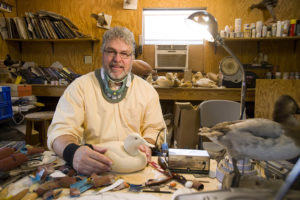Memphis resident and minister Kerry Smith has a big problem with limits on opioid prescriptions.
“The problem is chronic pain. That is what the problem is.”
Smith, 55 and a former church planter, is sympathetic to the addicts and their families who have suffered overdoses, wrecked homes and ruined finances to opioid addiction.
Many opioid medications are household names like codeine, Vicodin, Percocet, Dilaudid and morphin. They are so common, and so potentially addictive, that some prescription users are clueless about the potency of the medications they are taking. Consequently, many have ended up addicted — and ultimately users of heroin, the king of opioids. The nation is now faced with an epidemic killing 33,000 annually.

Kerry Smith in his woodworking shop. Smith wears braces on his neck, back and wrists to help alleviate his chronic pain. Smith advocates on behalf of chronic pain sufferers who fear CDC regulations which could restrict patient access to opioid medications prescribed for pain relief. (Brandon Dill/Special to The Commercial Appeal)
In response, many individual physicians and pain clinics are either limiting opioid prescriptions or eliminating them altogether.
And in June, Kentucky became one of the latest states to limit the amount of painkillers doctors can provide for acute pain.
But that focus on limiting medications prescribed for acute pain — such as that experienced after dental or medical procedures — is bleeding over into the way many doctors are treating chronic pain, too.
That’s the kind of persistent pain that can last weeks, months or longer. If the sufferer is lucky, the pain may lessen a few degrees at different points of the day.
For them — and definitely for Smith — opioids are a huge help in that daily battle.
But as opioid addiction has become more widespread, and as some addicts try to persuade physicians for more pills, the medical community has become defensive.
“The problem is that many pain clinics and many doctors, because of the fear of losing their licenses, are stopping the use of opioids,” Smith said.
That puts responsible users of painkillers in even more difficult situations, leaving some in the lurch.
Chronic pain is defined as pain lasting longer than 12 weeks, according to the National Institutes of Health.
“Chronic pain is the most common cause of long-term disability,” the NIH says. The condition often is accompanied by depression and post-traumatic stress disorder.
Smith has experienced daily pain for close to two decades, often exacerbated by surgeries meant to help it.
Every morning he wakes up with excruciating pain, modifying it with a mixture of medication, mindfulness, meditation, prayer and art.
Opioids have been part of that mix for years; he has taken them responsibly and is not addicted. But beginning about two years ago, he started having trouble getting those prescriptions filled.
“Never mind what the needs of the patients are,” he said. “Now it’s the FDA which determines what our needs are.”
Smith said he advocates for a patient-centered approach to managing pain, one where treatment is tailored to the chronic sufferer. But that approach isn’t being embraced, leaving Smith and others with chronic pain feeling forgotten in the reaction to the opioid epidemic.
“So we suffer — and this includes my family as well.”
Related stories:
Nation’s opioid epidemic reaches critical proportions as churches ask: ‘What can we do?’
Former minster now ‘prisoner of pain,’ but art ‘transports’ him to place of purpose
Related opinion:
Opioid abuse is a tragedy, crack cocaine use is a crime. Why? | Russ Dean
